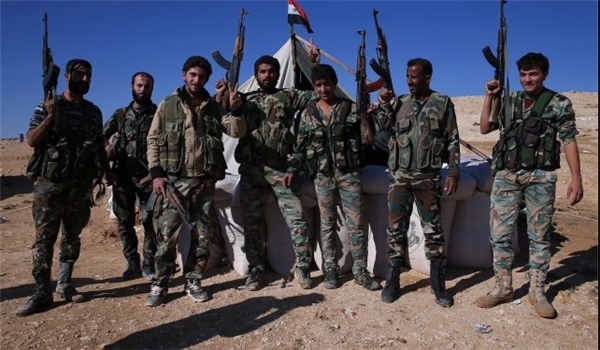Syria in Last 24 Hours: Army Wins Back Strategic Region in Aleppo Province

The army units won back a strategic village in Khanaser Plains in Aleppo province.
Scores of terrorists were killed and injured as the army was purging them from the newly captured areas in Aleppo province.
The Syrian army, popular forces and resistance forces also continued their military gains in other key provinces across Syria, inflicting heavy losses on them.
Aleppo
The Syrian Army troops and their popular allies continued to push the ISIL terrorists back from more positions in the Southeastern part of Aleppo province and seized full control over one more strategic village in the region on Sunday.
The Syrian army, Hezbollah, the Republican Guard, and the National Defense Forces (NDF) captured the village of Abu al-Karouz after a violent battle with the ISIL in the Khanaser Plains.
The village of Abu al-Karouz is located in Jabal al- Souss (Al-Souss Mountain), which is not far from the recently captured town of Khanaser.
The Russian fighter jets, in a fresh round of anti-terrorism combat flights on Sunday, bombed the concentration centers of the al-Qaeda-affiliated al-Nusra Front in the Eastern part of Aleppo province, inflicting major losses on the terrorists.
Gathering centers of the Nusra Front near Anadan, Hraytan, Qabtan al-Jabal, Maarat al-Artiq and Dar al-Izza came under the heavy bombardments of the Russian air fleet, which claimed the lives of several militants.
Nusra fighters’ military hardware also sustained major damage in the air raids.
Lattakia
The Syrian commandoes pushed the militant groups back from their positions in the Northern part of the coastal province of Lattakia and won back one more strategic height overlooking Turkey.
The Syrian army, the Syrian Social Nationalist Party (SSNP), the Syrian Marines, the National Defense Forces (NDF) and Liwa Suqour al-Sahra (Desert Hawks Brigade) imposed full control over Talat al-Nawareh after a tough battle with the terrorists of al-Nusra Front, Harakat Ahrar Al-Sham, and the Free Syrian Army’s “1st Coastal Brigade”.
The militant groups left behind scores of dead and wounded members and fled their strongholds in the Northern part of Lattakia province after coming under heavy attacks by the Syrian Army and National Defense Forces.
The Syrian government forces engaged in a tough battle with the terrorists of al-Nusra Front and forced them to pull fighters back from the small town of al-Saraf in the Northwestern side of Rabei’eh.
Deir Ezzur
The Syrian government forces detected and destroyed a tunnel used by the ISIL militants in the Eastern city of Deir Ezzur, military sources said Sunday.
“The Syrian army troops and the National Defense Forces (NDF) seized a supply tunnel of the ISIL in the Old Airport District after fierce clashes with the terrorist group,” the sources said.
In the meantime, one of the ISIL bases, its satellite communication station and a fuel reservoir near the village of al-Sfaira al-Fouqani were destroyed in the Syrian government forces’ offensives.
Reports said earlier that the Syrian warplanes carried out several combat flights over the ISIL gathering centers in different parts of the Eastern province of Deir Ezzur and targeted them heavily leaving several terrorist commanders dead.
The Syrian army’s aircraft tracked and targeted a hideout of the ISIL leaders in the villages of al-Sfaira al-Fouqani in the Northwestern part of the city of Deir Ezzur, which ended in the killing of several leaders of the group.
In the meantime, the ISIL concentration centers in the villages of al-Jafra in the Eastern part of the province came under the heavy strike of the Syrian fighter jets, which destroyed the militant centers’ infrastructures.
The Syrian Army’s anti-terrorism operation in the Eastern province of Deir Ezzur near the border with Iraq ended in the killing of at least 20 ISIL terrorists.
The Syrian army stormed the ISIL concentration centers in the regions of al-Kataf and al-Mosamakah near the town of Albu Kamal, destroyed their military equipment and killed or wounded many of the militants.
Raqqa
The ISIL terrorist group confirmed on Sunday that it has pulled its fighters back from a key town in the Northern part of Raqqa province at the border with Turkey under the heavy attacks of the Kurdish People’s Protection Units (YPG) alongside the Syrian Democratic Forces (SDF).
The Kurdish fighters have significantly advanced against the ISIL militants in the town of Tal Abyadh and have pushed the terrorists back form the town.
The YPG and SDF fighters are now engaged in fortifying their positions inside and outside of the town.
The ISIL suffered a heavy death toll in the attacks.
Hama
The Syrian army fended off the ISIL offensives in al-Salamiyah region and forced the terrorists to retreat from the battlefront under heavy fire.
The ISIL attempts to prevail over the government forces’ lines of defense near the axis of Bari al-Sharghi, Aqareb, Ghab al-Basel and Tal Abyadh were repelled by the Syrian army.
The ISIL left behind scores of the dead or wounded members and fled the battlefront.
The Syrian army also destroyed a number of the ISIL vehicles and military equipment.







